Among the fallen heroes, two dogs rest
May 26, 2011
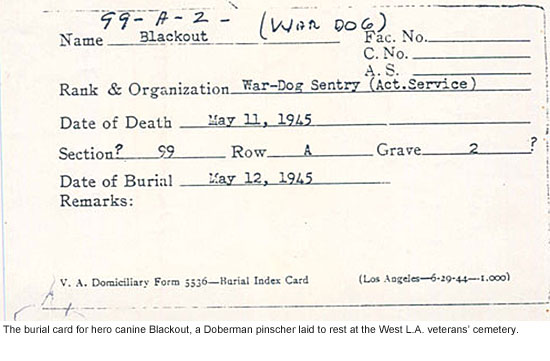 In all the solemn grandeur of the Los Angeles National Cemetery, with its stirring rows of white grave markers and leafy glades, the final resting places of Bonus and Blackout are footnotes, really—unmarked and all but forgotten.
In all the solemn grandeur of the Los Angeles National Cemetery, with its stirring rows of white grave markers and leafy glades, the final resting places of Bonus and Blackout are footnotes, really—unmarked and all but forgotten.
But something about the two dogs—the only canines believed to be buried on the West Los Angeles grounds—captured the imagination of Dan Leyva, the cemetery’s longtime foreman. Who were these dogs, laid to rest during separate ceremonies in the mid-1940s, and how do they fit into the cemetery’s story?
So several years ago, Leyva rode a bus to downtown Los Angeles, went into the Central Library and asked to be directed to the oldest newspapers they had.
Painstakingly, over the course of three hours, he went through old issues of the Santa Monica Evening Outlook until he found them—short articles explaining how Bonus and Blackout ended up finding their final resting places among some of the cemetery’s legendary dead, including more than 100 Buffalo Soldiers, the father of Wyatt Earp and an impressive roster of Medal of Honor recipients. (A more detailed list is here.)
Blackout, it turns out, was a real war hero. The 5-year-old Doberman pinscher had been assigned to duty as a war dog sentry during WWII. After nearly two years of service, shell-shocked and suffering from more than a dozen wounds sustained on the frontlines, Blackout returned to Los Angeles to great acclaim, earning a citation ribbon from the American Kennel Club. But “in spite of all that veterinary science could do for him,” the article said, Blackout never recovered and had to be euthanized.
The headline on the article, dated May 12, 1945, read: “Military Funeral Given Canine Hero.”
Bonus, on the other hand, was no angel—although he’d evidently been deeply loved by the retired soldiers whose companion he’d been at the Sawtelle Soldiers Home. The 11-year-old Husky, who died of poisoning, had actually been barred in life from the cemetery grounds because he’d bitten two guards there. Leo J. Britt, a World War I Purple Heart winner, took a lead role in the dog’s burial “under a pepper tree in a secluded spot” on May 3, 1943, according to the newspaper account:
“Bonus’ funeral was simple. While a group of veterans stood with bowed heads, Britt placed a robe, a collar and his last box of dog biscuits on the wooden casket, on which had been lettered in gold, ‘Bonus—Our Beloved Friend.”
War dogs are still a part of the military, playing a role in the recent Navy Seal raid on Osama bin Laden’s compound, for example. And another noble military animal is at the center of the hit play “War Horse,” now winning rave reviews in New York for its depiction of a cavalry horse during World War I.
But burial of animals is no longer permitted at the cemetery, which was dedicated in 1889 on land that also housed the Pacific Branch of the National Homes for Disabled Volunteer Soldiers. The site, located at 950 S. Sepulveda Boulevard in Westwood, has grown over the years to its current 114 acres.
On Memorial Day, Monday, May 30, a program honoring the men and women who gave their lives for their country is scheduled for 10:30 a.m. at the cemetery. Those with an interest in the facility’s canine history might want to add a side trip to their visit. They will find Bonus buried with his handler, Charles E. Temple, an ensign in the Navy Reserve, in Section 101, Grave 1, Row A. Blackout is buried with George Lewis Oshier, a Navy cook and Marine Corps sergeant, in Section 99, Grave 2, Row A.
Leyva, who served for 8 years in the Navy before beginning his 32-year career at the cemetery, said that visitors seldom inquire about the dogs.
“People usually don’t ask us. Nobody really knows about it,” he said.
But he thinks there’s something about the dogs’ service that is worth remembering.
“Especially Blackout, to me, is kind of like a hero,” Leyva said. “He protected our troops and came back home.”
Posted 5/26/11
A time to honor and remember
May 26, 2011
What started out as “Decoration Day” in post-Civil War America is now a national holiday—and a time to reflect on those who, in Lincoln’s words, “gave the last full measure of devotion” to the cause of preserving and protecting the United States.
Here are some of this year’s Memorial Day observances in and around the 3rd District:
- “Honor and Remembrance,” a program at the L.A. National Cemetery, will feature retired Army Major General John T. Crowe as keynote speaker and David James Elliott, of TV’s “JAG,” as master of ceremony, along with celebrity readers including Gerald McRaney. A band begins playing at 10 a.m. on Monday, May 30, with the ceremony getting underway at 10:30 a.m. The cemetery is located at 950 S. Sepulveda Blvd., Los Angeles, 90049.
- Forest Lawn will feature patriotic programs in many locations, including at Forest Lawn Hollywood Hills. The free program, in the forecourt of the “Birth of Liberty,” begins at 10 a.m. Monday.
- Canoga Park’s Memorial Day Parade starts at 11 a.m. Monday. It will feature military marching and equestrian units, brass bands, floats, guest VIPs, classic and antique cars, local youth groups and even military aircraft flyovers. After the procession, Quimby Park hosts a festival with music, food and vendors.
For a look at Memorial Day observances around the county, here is a list compiled by the county’s Department of Military and Veterans Affairs.
Posted 5/26/11
This beach beauty’s a bargain
May 25, 2011
 If you’d like to splash and lounge like a Gilded Age big shot on Santa Monica’s Gold Coast this weekend, have we got a tip for you.
If you’d like to splash and lounge like a Gilded Age big shot on Santa Monica’s Gold Coast this weekend, have we got a tip for you.
The Annenberg Community Beach House, owned and operated by the City of Santa Monica for public use, will be opening its pool for the long Memorial Day weekend. The pool’s actual season runs June 25-Labor Day, so this is a three-day chance to get an early jump on summer—while savoring one of the choicest beachfront locales anywhere.
The pool is just one amenity at the 5-acre oceanfront property, once the site of Marion Davies’ fabled beach mansion and playground for the likes of Charlie Chaplin, Greta Garbo, Clark Gable and, naturally, William Randolph Hearst, who built the humble 100-plus-room beach shack in the 1920s for Davies, his longtime mistress.
The property opened to the public two years ago, after previous incarnations as a grand hotel and the Sand & Sea Club. (The mansion was torn down in 1956, but Davies’ guest cottage is still on the site and tourable.) Funding from the Annenberg Foundation enabled the city of Santa Monica to clean up hazardous materials on the property, restore the pool and create an architecturally significant compound with some serious environmental cred. The Beach House has LEED Gold certification and runs on wind-generated power, while water for the pool and “splash pad” area are heated by solar collectors.
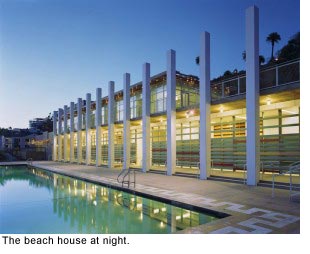 Beach real estate this choice doesn’t come along often, and pool admittance is on a first-come, first-served basis. So if you’d like to secure a place in the sun this weekend, a little advance planning may be required. Same-day pool passes will go on sale starting at 9:30 a.m. on Saturday, May 28, Sunday, May 29, and Monday, May 30. Admission is $10 for adults, $5 for seniors over 60, $4 for children under 18. Reservations also are available online starting three days in advance.
Beach real estate this choice doesn’t come along often, and pool admittance is on a first-come, first-served basis. So if you’d like to secure a place in the sun this weekend, a little advance planning may be required. Same-day pool passes will go on sale starting at 9:30 a.m. on Saturday, May 28, Sunday, May 29, and Monday, May 30. Admission is $10 for adults, $5 for seniors over 60, $4 for children under 18. Reservations also are available online starting three days in advance.
The Annenberg Community Beach House is located at 415 Pacific Coast Highway, north of the Santa Monica Pier. (Directions are here.) Parking is $8 on the weekends, but you can avoid the charge—and get into the eco-friendly spirit of the Beach House—by getting there on bicycle, via the Pacific Coast Bike Trail.
Nan Friedman, the Beach House manager, said a number of “summer-inspired” classes are coming this year, exploring everything from stand-up paddleboarding and open ocean swimming to sand games such as disc golf.
That ever-evolving list of featured classes and cultural attractions is another reason to discover the facility. “Oddly enough,” Friedman said, “there are people from all over the world who know about the Annenberg Beach House and we also have people who live locally who say, ‘I drive by every day and I never knew what it was.’ ” If you’re one of them, this just might be your weekend to find out.
Posted 5/25/11
Horseplay at the aquarium
May 25, 2011
 You dads out there might be feeling pretty good about yourselves with Father’s Day just around the corner. But sorry, Pops, the seahorse has you beat.
You dads out there might be feeling pretty good about yourselves with Father’s Day just around the corner. But sorry, Pops, the seahorse has you beat.
The male seahorse is so devoted that he carries as many as 1,000 offspring deposited by the mom in a brood pouch for 14 days, until they hatch. At that point, with the fry fully formed, the father is pretty much done with parenting chores. But for those two weeks, he’s as attentive as they come.
The seahorse, like the giant panda on land, is one of those iconic creatures that seem to naturally capture our affection and pique our curiosity. Maybe it’s the odd shape, maybe it’s that comic snout they use to suck in food, who knows? It’s hard to even remember they’re fish.
For Randi Parent of the Santa Monica Pier Aquarium, the attraction of seahorses is in the way they move.
“They kind of have that vertical thing going for them,” she said. “Their locomotion is just so different from other marine animals – it’s captivating.”
Also like the giant panda, these creatures, especially the native Pacific seahorse, can serve as a symbol for conservation efforts.
“Pacific seahorses live close to the shore in tall marine grasses,” said aquarium Director Vicki Wawerchak, “which makes them very susceptible to coastal development and subject to capture and overfishing. Never buy dried seahorses at novelty shops.”
Why buy a lousy dried one, anyway, when you can see a whole herd of them live at Santa Monica Pier Aquarium’s new exhibit? The Pacific seahorse featured in the exhibit grows up to 12 inches and is the only species found along California’s coast.
As part of a special aquarium promotion, seahorses are also available for “aquadoption” at a cost of $50 (it goes to $250 after July 1). Adoptive parents make an investment in the animal’s care and, in return, receive an adoption certificate photo, free aquarium passes and a year’s membership to Heal the Bay, along with the satisfaction of contributing to the preservation of marine life.
More than 100 other species are also on display at the Aquarium, which is Heal the Bay’s forum for educating the public about marine life. Heal the Bay is a nonprofit organization whose mission is to keep coastal waters and watersheds of SoCal clean and safe.
The exhibit opens this Saturday, May 28. Aquarium hours are 2 p.m. to 6 p.m. Monday through Friday, and 12:30 p.m. to 6 p.m. on the weekends. There is a suggested donation of $5 for admission (or a $3 minimum entry fee). Kids 12 and under get in free. The Aquarium is located at the beach level of the Santa Monica Pier, 1600 Ocean Front Walk.
Posted 5/25/11
Behind the scales at “The Biggest Loser”
May 24, 2011
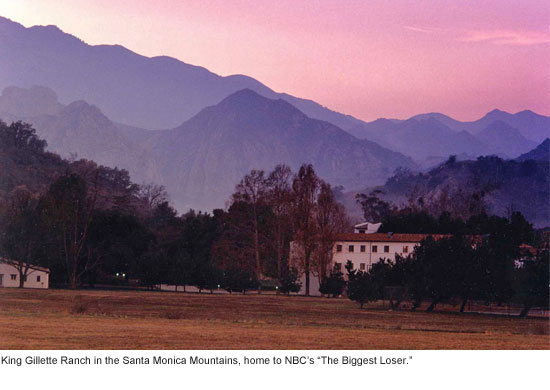 On the hit TV show “The Biggest Loser,” it’s known simply as “The Ranch”—a serene, sprawling property where thousands of pounds and decades of shame have been shed during the past four years.
On the hit TV show “The Biggest Loser,” it’s known simply as “The Ranch”—a serene, sprawling property where thousands of pounds and decades of shame have been shed during the past four years.
For months at a time, the mountainous acreage is home to dozens of contestants who battle their demons and their weight to gain the title of “The Biggest Loser,” along with a tidy purse of $250,000. But the property, complete with its Hollywood-imported state-of-the-art gym, is no ordinary production set.
Unbeknownst to the NBC show’s millions of fans, who’ll be tuning in for tonight’s finale, “The Ranch” is one of Los Angeles’ most historic and dazzling properties, designed by famed architect Wallace Neff in the late 1920s for razor-blade tycoon King Gillette. In 2005, an unprecedented coalition of government agencies, including Los Angeles County, raised $34 million to protect the ranch’s 600 oak-studded acres from expansive development.
Located along Mulholland Highway in Calabasas, King Gillette Ranch is being transformed into a gateway destination for the Santa Monica Mountains recreation area. A new visitor’s center currently is under construction there. The property is operated by the Mountains Recreation and Conservation Authority, which receives $50,000 a month from the show to help underwrite the agency’s operations throughout the region.
Managing the property for the MRCA is ranger Scott Hughes, a fit and trim Army veteran who has the tricky job of ensuring that the public has unfettered access to the property—including dozens of grade-school campers—while helping the show’s producers create an illusion of exclusivity and privacy. Talk about your mixed-use property.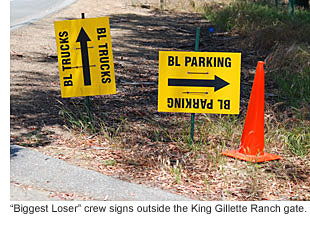
“There’s no effective job description for this position,” Hughes says. “I add something new to it every day.” One thing, however, remains a constant above all else, he says. “It’s my job to protect this property.”
Living on the grounds with his wife and a 15-year-old son, Hughes has gotten to know not only the production crew but each of “The Biggest Loser” contestants, some of whom arrive weighing nearly 500 pounds and carrying a heavy psychological burden that has been with many of them since childhood.
“Season after season, you see them around the property,” Hughes says. “You can see the sadness in their eyes.” But then, after weeks of healthy dieting and high-intensity workouts, “you can literally see their spirits lift. It’s an amazing transition.”
There’s also been a fair share of drama on the ranch, including romances and, this season, the abrupt departure of one of the contest’s frontrunners—former Olympic wrestler Rulon Gardner, who won a gold medal in the 2000 Sydney Summer Games by beating the seemingly invincible Russian Alexander Karelin.
Gardner, 39, came to the ranch weighing 474 pounds, 200 more than during his storied wrestling career. In late April, after having lost 188 pounds, he announced during the show that he was going home “for personal reasons”—the first contestant to voluntarily walk away from the ranch, leaving behind mystery and speculation about his hasty exit.
“The Biggest Loser’s” relationship with the ranch began shortly after it was acquired as public land from the previous owner, Soka University, which had been blocked in its plan to expand the campus to accommodate some 5,000 students. The show’s crew had come to film a single competition, or “challenge,” between the contestants in season four.
But the producers quickly recognized that the property’s beauty and its structures would represent a substantial upgrade. Back then, contestants were living in the state’s old mental institution in Camarillo. Now they’d be bunking in an annex to the Gillette mansion built in the late 1950s for an order of monks by one of the ranch’s several owners over the decades, who have included MGM director Clarence Brown and church leader Elizabeth Clare Prophet.
On a recent day at the ranch, the “Biggest Loser” crew was busy preparing the place for the upcoming season, which starts production in early June. The kitchen, with its to-die-for appliances, is being redone, as are the “living room” and the bedrooms. Ranger Hughes was making sure that a dead oak limb was carefully cut by his staff so that it would not collapse on an outdoor table where interviews with contestants are sometimes filmed.
Despite all the activity, Hughes says, “this is the calm before the storm. The storm is when there’s 80 to 100 people here.”
Posted 5/24/11
Ups and downs at the Hall
May 24, 2011
 As everyone who hits a certain age is well aware, passing a 50th birthday can bring with it certain physical indignities.
As everyone who hits a certain age is well aware, passing a 50th birthday can bring with it certain physical indignities.
The county Hall of Administration, at 51, is no exception.
A recent spate of mishaps—including staffers getting stuck in elevators and a flood that doused three county supervisors’ offices—has brought some of the building’s maintenance challenges into sharp relief.
The county’s Internal Services Department, responding to a series of questions raised by supervisors at their May 17 meeting, explained that the water leak that flooded parts of the 2nd, 3rd and 4th District supervisorial offices on May 13 was caused by “routine maintenance work to replace heating and air conditioning water coils located above the 8th floor ceiling.” Maintenance routines are being reviewed to avoid a repeat performance.
As for those elevators, ISD responded to the supervisors’ publicly-aired gripes by rewiring the audible alarm system in the cars so that they now ring at the Hall’s 2nd floor sheriff’s station. Previously, the alarms could be heard only in the halls immediately outside the elevator. (The elevator cars also have “in-cab” telephones to reach the county operator.)
Routing the alarms to the sheriff’s station “should improve response time to entrapment incidents,” ISD director Tom Tindall said in a memo to supervisors this week. He also said the Hall’s 11 elevators, which include private elevators used by top county officials, are up to code and inspected regularly by the county, in addition to annual state inspections.
Some 2,700 county employees and several hundred visitors are in the Hall on any given workday. Since June 1, 2010, seven of them have reported getting stuck in the elevators, according to the county’s work order tracking system. And some of the unlucky seven have had VIP bosses.
“My staff member was stuck in there over an hour,” Supervisor Don Knabe said. Supervisor Michael D. Antonovich, who said his staff also had been stranded in the elevators in recent weeks, asked for a report on what it would cost to upgrade the elevator equipment at the Hall of Administration and the Stanley Mosk Courthouse.
“I know those of us who’ve served on jury duty…have a very difficult time getting to the court because you wait a lifetime for the elevator,” Antonovich said.
Estimates for replacing the elevator equipment will be submitted to supervisors by June 15, Tindall said.
Posted 5/24/11
Your summer right to an easier flight
May 23, 2011
 With summer vacation planning in full swing, the Los Angeles County Department of Consumer Affairs has some good news.
With summer vacation planning in full swing, the Los Angeles County Department of Consumer Affairs has some good news.
Beginning in August, federal authorities will be cracking down on oversold flights, baggage fees, sneaky ticket surcharges and long delays on the tarmac, thanks to new airline passenger rules.
“This is a really good change for consumers,” says Acting Director Rigo Reyes. “One of the complaints we get all the time is that when airlines bump you or lose your luggage, they compensate you too little and too late—it’s, ‘File your claim and we’ll get back to you’.”
Under new U.S. Department of Transportation passenger rights that take effect Aug. 23, passengers who are bumped from an oversold flight will be entitled to more money—up to $650 for short delays (of less than four hours), and up to $1,300 for longer ones.
Moreover, airlines will not only have to reimburse passengers for lost luggage, as is now the case, but also will have to refund those irritating extra baggage fees.
“And they will have to be very clear about extra fees beyond your fare when you book online,” says Reyes. “They won’t be able to put you in that position where you see a promotion and spend all this time setting it up, and then find all these sorts of fees you didn’t know about tacked on when you see your credit card bill.”
Also, he says, no airlines, whether foreign or domestic, will be allowed to hold passengers for endless hours on the tarmac as was the case during a December blizzard at John F. Kennedy International Airport in New York last year.
After August, four hours will be the limit, and airlines will have to give passengers status reports on the half-hour and make sure they have food, water, bathrooms and medical treatment, if needed, after two hours.
Posted 5/23/11
An American original craft art show
May 19, 2011
 Ramona Otto’s art has an “only-in-America” ethos, channeling folk traditions and contemporary life into unique and riveting pieces. See for yourself at an exhibition beginning Saturday, May 21, at the Craft in America Study Center, 8415 W. 3rd Street, Los Angeles. The show, “Found in America: Americana Assemblages and Patriotic Puns,” will run through Saturday, August 30.
Ramona Otto’s art has an “only-in-America” ethos, channeling folk traditions and contemporary life into unique and riveting pieces. See for yourself at an exhibition beginning Saturday, May 21, at the Craft in America Study Center, 8415 W. 3rd Street, Los Angeles. The show, “Found in America: Americana Assemblages and Patriotic Puns,” will run through Saturday, August 30.
To RSVP for the opening reception, call (323) 951-0610, or email [email protected].
Posted 5/19/11
Word lovers unite in Sylmar
May 18, 2011
Fancy yourself a linguist or logophile? Feast your ears on the lyrics, poems and prose of SoCal culture at the 6th Annual Celebrating Words Festival in Sylmar.The affair kicks off with an ancestral Mexican dance by Temachtia Quetzalcoatl.
Following that, there will be readings, discussion panels, and book signings by accomplished writers including Luis J. Rodriguez, Reyna Grande, and Crista Flanagan (also known for her work in the hit TV series Mad Men.) There will also be musical performances from Latin rockers La Santa Cecilia and others. Children’s activities, community resources and local food vendors round out the day’s offerings.
The festival, presented by Tía Chucha’s Centro Cultural & Bookstore and sponsored by City of L.A. Department of Cultural Affairs, Los Angeles Mission College, and L.A. County Supervisor Zev Yaroslavsky, seeks to promote literacy and self-expression through all words sung, performed and written.
The Celebrating Words Festival is a free event that takes place Saturday, May 21, from 1 to 7 p.m. in the Los Angeles Mission College campus quad at 13356 Eldridge Ave. Sylmar CA 91342.
Posted 5/18/11





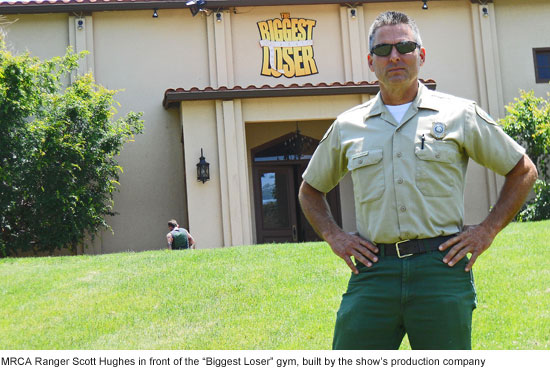
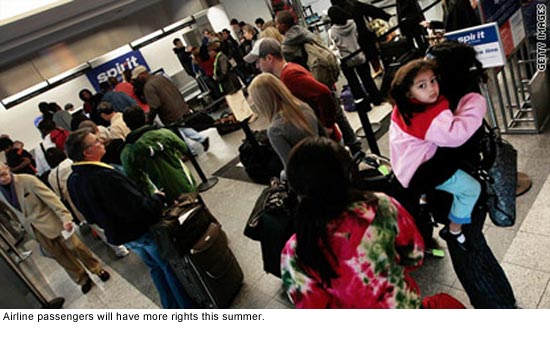






 Check for the latest closure information
Check for the latest closure information








